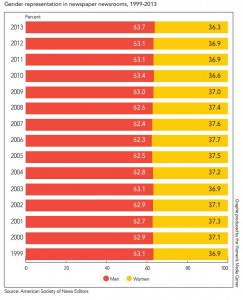By CHELSEY SELLARS
Don’t get me wrong, Anderson Cooper is one of my favorite players in the news game, but where are the female reporters?
In the studies conducted by the Women’s Media Center, there was a huge lack of representation of women in the United States media industry in 2014.
“The American media have exceedingly more distance to travel on the road to gender-blind parity,” said Julie Burton, president of Women’s Media Center.
The studies included all aspects of media: newspapers/magazines, TV/digital news, sports journalism, and entertainment/film to name a few.
Amongst all categories, men ruled the media. More specifically, white men were the largest represented demographic.
As an Hispanic, female reporter, what does that mean for me? I already have two strikes placed upon me; right off the bat, I’m at a disadvantage.
Gender disparity in journalism leads to a loss in content quality. For a media company to best serve its audience, it needs to appeal to the public with a variety of voices and topics.
An article on the winged-eyeliner or ailments to menstrual cramps just doesn’t seem as credible coming from a male than a female.
The way a news story comes together is also heavily affected by the gender of the reporter. For example, the University of Nevada at Las Vegas analyzed how many front page stories of The New York Times included female sources in January and February 2013. A whopping 19% of the sources came from females. Nothing shocking here; with such a high volume of men in the media, it only seems natural that they would gravitate towards a male source.
So, to put this in perspective, imagine a headline about a treatment for hair loss. If all the sources for this headline are male, how will this article appeal to women? This privation of women sources can lead to bias in the media; as if there wasn’t enough already.

